|
Chrysanthemum is one of the leading cutflowers and potted plants in the international
market. Domestic market has increased both for cutflowers and potted plants. Local
production cannot cope with the demand, thus the importation of this cutflower from
other countries.
The development of chrysanthemum industry as a major ornamental cutflower and potted
plants enterprises supports the major thrusts of the government to develop the non-traditional
export products that will boost the industry to earn dollars. The immediate benefits
from chrysanthemum production will substitute the imported flowers with locally
produced ones.
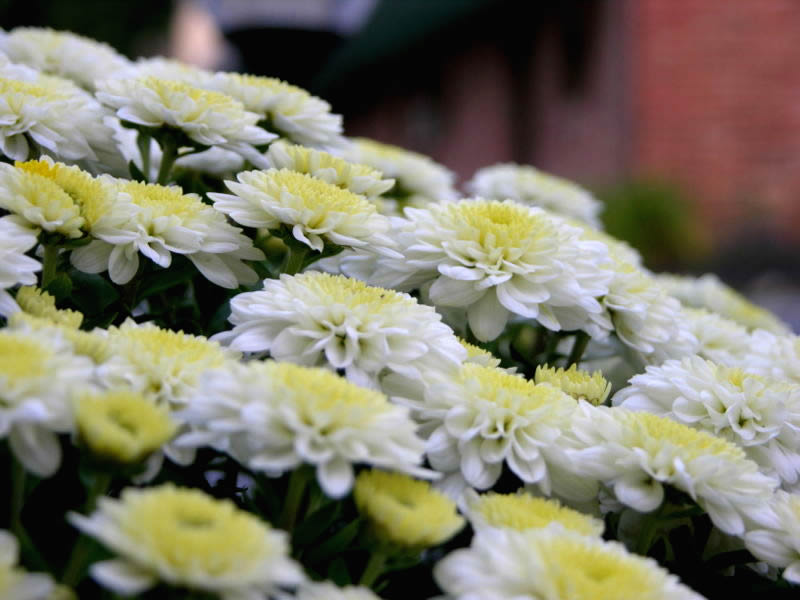
|
|
Chrysanthemum sp.
|
Characteristics
Yoder’s Spray Chrysanthemum Advisory Team recently developed these standard
terms to clear up confusion in the spray mum marketplace for improved communication
among growers, wholesalers, retailers, wire service outlets and consumers.
Arrangement – These varieties’
flowers have long enough individual stems to break off for use in mixed flower arrangements.
Availability – Yoder
breeds spray mum varieties for both North American and Latin American producers.
Because variety performance may vary in these regions, some varieties may not perform
satisfactorily if produced outside of their preferred region.
Bouquet – Varieties are
well suited for use in individual or mixed bouquets. Individual flower stems are
typically shorter than those varieties for arrangements.

|
Button – A spray mum
flower form typically less than 1¼” in diameter, comprised almost entirely
of ray petals. It is usually round or slightly crested in appearance.
|
Center Bud Removal (CBR) –
The process of removing the top-most or “center’” bud on each
stem in order to open up the formation of the spray (laterals) to promote more uniform
flowering. [The opposite of disbud.]
|
Cushion – A spray mum
flower form typically more than 1 ½” in diameter, comprised almost
entirely of ray petals. It is usually flat or slightly crested in appearance. Formerly
called “decorative”.
|

|

|
Daisy – A spray mum flower
form comprised of outer (ray) petals radiating out from the perimeter of a close-cropped
center “eye” (disk).
|
Decorative – As applied
to a spray mum flower form, this term is no longer used. See cushion.
Disbud – The process
of removing all lateral buds from a stem, leaving only the top-most or center bud
to develop. [The opposite of center bud removal.]
Disk (or disk florets) –
The close-cropped center petals a daisy spray mum; or the “puffed”,
more elongated petals of a duet spray mum.
Duet – A spray mum flower
form comprised of two distinct kinds of petals: 1) a prominent “puffed”
center of elongated disk florets and
2) ray petals radiating out from the perimeter of the center disk.
|

|
Exotic – A descriptor
for any spray mum flower form in which unusual petal characteristics make it distinctly
different from mainstream varieties. For example, a cushion with feathered, spoon-tipped,
quill-tipped, curled or otherwise unusual petals would be called an exotic cushion.
Feathered – Specifically
describes the exotic characteristics of petals which have a raggedy or feather-like
shape.
Flower Size – Classified
according to average diameter of mature flowers: petite- less than 1 ¼ inches,
small - 1 ¼ to 1 ¾ inches, medium - 2 to 2 ¾ inches, large
– 3 to 3 ¾ inches and extra large – over 4 inches.
Novelty – As applied
to spray mums, this term is no longer used.
Pompon – As a synonym
for “spray mum” or the “button” flower form of spray mums,
this term is no longer used.
Quill-tipped – specifically
describes the exotic characteristics of ray petals which have an elongated tubular
shape resembling a feather quill.
Ray petals or ray florets –
The outer perimeter petals of a flower.
Recommended – The time
of year when reliable performance can be expected in North America. This may vary
according to local light and temperature conditions. Latin American producers should
check with their local supplier for recommended flowering periods in their region.
Response – Each variety
has a week response, which indicates the length of time it takes to flower (2/3
to ¾ open stage) with proper cultural conditions after “short day”
treatment begins. Varieties which can be grown as either disbuds or sprays often
require 3 to 5 more days if spray treatment is given.

|
Spider – A spray mum
flower form comprised of elongated tubular petals that are often curled at the ends.
|
Spoon-tipped – Specifically
describes the exotic characteristics of ray petals which have an elongated tubular
shape similar to quill-tipped but more flattened at the tip, resembling a spoon.
Spray – A flower stem
having multiple flowers (see center bud removal).
Spray Mum – This term
replaces “pompon” or “cut mum” to describe this type of
cut chrysanthemum having multiple flowers per stem. Technically a “CBR”
(center bud removed) stem belonging to the species Chrysanthemum ×morifolium
of the Compositae family of flowers, having multiple laterals with one flower per
lateral. Its flowers may have the form of a button, cushion, daisy, duet or spider.
Standard – A mum and
standard chrysanthemum flower stem having only a single flower (see disbud).
Vigor – Understanding
the relative vigor (short, medium, tall) helps in planning lighting schedules and
growth regulation application.
Top
Climate and soil
The best temperature for growing chrysanthemum ranges from 20 - 280 C
for day and 15 - 200C for night. Chrysanthemums are short day plant,
which requires short days or long nights to flower. The critical day length is 14
- 15 hours for flower initiation and 13 -14 hours for development.
Any soil that permits good drainage and aeration is suitable for chrysanthemum.
A medium consisting of 1 part compost, 1 part garden soil and 1 part animal manure
or the combination of compost and coir dust, or rice hull or garden soil can be
used. A pH of 6.0 - 6.5 is recommended.
Top
Varieties
Selection of the cultivars depends on the purpose of the growers and the inherent
characteristics of the cultivars to be used:
For cutflower production in the highlands:
1. Golden Princess Anne
2. Bowl of Gold
3. Otome (White and Pink)
4. Taiwan Yellow
5. Taiwan White
For potted chrysanthemum:
1. Kikubiyori
2. Snowball
3. Genie
4. La France
5. Rhapsody
6. Red headline
7. Miss Hiroshima
8. Algiers
9. Capistrano
10. Autumn Fire
For lowland areas, the following cultivars have shown great performance:
1. Jean series - Jean red, Jean white and Jean yellow
2. Shin shong - Taiwan Yellow
3. kaingan - large yellow standard type
4. Sekaiteit - Taiwan Yellow
Top
Propagation
Methods of propagation
- Cuttings
- Division/stolons
- Seeds
- Grafting
- Tissue culture
Planting
Rooted cuttings can be planted directly into raised beds or pots. Distance of planting
varies according to the season. As more space per plant is allowed during those
periods when light intensity is comparatively less.
The conventional spacing between the 1-meter wide beds is 15 x 15 cm during the
dry season months and 15 x 20 cm during the wet season months.
Top
Cultural
practices
Water management
Chrysanthemum needs only small amount of water during the stages of growth but it
is important to avoid water stress during the vegetative growth. Water requirement
increases as vegetative growth progresses. However water requirement should be reduced
as the plants approach the flowering stage.
Nutrient management
Chrysanthemum takes up relatively large amount of both nitrogen and potassium during
the vegetative growth. If the plants are already established, liquid fertilizers
containing about 210 ppm N and 220 ppm potassium that should be added every 2 -3
weeks interval until buds show color.
Intercultural operations
Support/Staking
Since spray and standard chrysanthemums may be as tall as 30" to 36",
it is necessary to support the stems as the crop matures. Generally, chrysanthemum
are tied to bamboo stakes, metal hog wire or sturdy sticks to keep them erect and
properly hold flowers on the main stem of the flowers.
Pinching and disbudding
Pinching on the growing tip of the plant is done to induce branching and increase
the number of flowering stems per plant.
Disbudding for standard mums or "single flower" group. Lateral buds are
removed to allow terminal bud to develop into a big flower.
For spray types, the terminal bud is removed to develop a spray of large uniform
flowers from lateral buds.
Top
Plant protection
Pests
Aphids, thrips, leafminers and mites are the common insects attacking chrysanthemum.
Spraying with any recommended insecticides may control the infestation.
Aphids (Macrosiphoniella sanborni):
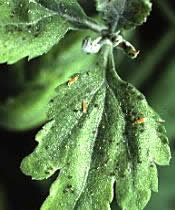
|
Greenish-black nymphs and chocolate brown adults suck the cell sap from growing
shoots and lower surface of leaves. Damage by aphid's results in loss of vigour,
yellowing and premature leaf fall and stunted growth of attacked plants. Honey dew
secreted by aphids favours development of sooty mould. The pest also acts as a vector
of viral diseases.
Control : Grubs and adults of Coccinellid beetles prey upon the aphids and effectively
wipe out their population.
|
Thrips (Frankliniella sp.):
|
Slender, white coloured nymphs and black adults feed on tender leaves causing silvering,
mottling and distortion of leaves. Damaged flowers look discoloured, withered and
dried due to scorching. Severe infestation adversely affects quality and quantity
of flower production.
Control : Drenching the soil with good insecticide also helps in reducing the population.
|
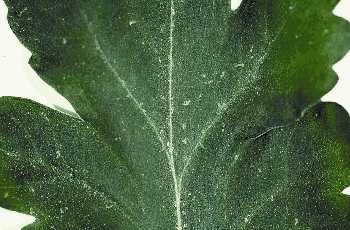
|
Leaf Folder (Hedylepta indicata):
It occasionally attains a status of serious pest on chrysanthemum. Pale-white coloured
eggs are laid singly or in small groups on lower side of leaves. Green coloured
larvae with brown head fold leaves together and feed on chlorophyll. The affected
leaves get skeletonized and dry. The larvae also damage flowers.
Control : Cutting and burning infested plant parts reduces pest infestation. Two
or three sprays of Quinalphos @0.05% gives effective control of leaf folders.
Bud Borer (Helicoverpa armigera):
Female adult deposits round, cream coloured eggs singly on bracts and petals of
buds. Larvae feed on growing flowers resulting in considerable flower loss.
Control: Collection and destruction of damaged buds and flowers reduces further
damage. Setting of light traps helps to control adult population by attracting them.
Hairy Caterpillar (Spilosoma obliqua):
Female moth lays eggs in clusters on lower side of leaves. Black coloured matured
larvae feed voraciously on leaves and buds and cause severe defoliation.
Control : Collection and destruction of egg masses and leaves infested with early
larval instars of hairy caterpillar reduces pest build up. Deep ploughing in summer
exposes pupae to predators.
Termites (Microtermes obesi):
Termites mainly feed on roots. In case of severe infestations they spread to stem
portion of the bark. Attack by the pest becomes severe under dry soil conditions.
Damaged plants wilt, dry and finally die if infestation is very high.
Control : Deep ploughing destroys the termite colonies. Proper irrigation and avoiding
dry soil conditions prevents pest build-up. Drenching the soil with Chlorpyriphos
@0.05% before planting protects plants from termite attack.
Lesion Nematode (Pratylenchus coffeae):
The nematode causes heavy root damage, which subsequently leads to poor growth of
chrysanthemum. The symptoms are in the form of stunting of plants with premature
yellowing and drying of leaves, reduced flower size and dark lesions on the roots.
Control : Application of neem cake @ 1ton/ha or Carbofuran @ 2kg/ha reduces the
nematode population.
Bud and Leaf Nematode (Aphelenchoides ritzemabosi):
The nematode causes considerable damage to the foliage of chrysanthemum. Interveinal
discolouration of leaves and their death is the characteristic symptom.
Control : Hot water treatment of suckers at 46°C for 5 minutes and spraying
0.02% Thionazin on aerial parts is recommended.
Diseases
Cercospora leaf spot, Alternaria leaf spot, Fusarium stem rot and powdery mildew
are the common diseases attacking chrysanthemums. Using any fungicide can control
these diseases.
Wilt (Fusarium oxysporum f.sp. chrysanthemi):
Initial symptoms are in the form of yellowing and browning of leaves. Affected leaves
die from the base of the plant upward. Infected plants are stunted and often fail
to produce flower. Wilting may cause rotting of root or the base of the stem.
Control : Since the disease is soil borne it is difficult to control with chemicals
alone. Drenching the soil with Dexon or Carbendazim is very effective. Before planting
dipping the rooted cuttings in a solution of Thiram @1.5g/litre of water is effective.
Since the disease spreads mostly through cuttings, it is important to use disease
free planting material. Disease can further be minimised by following strict sanitation;
periodical monitoring; crop rotation and rouging of infected plants.
Rust (Puccinia crysanthemi):
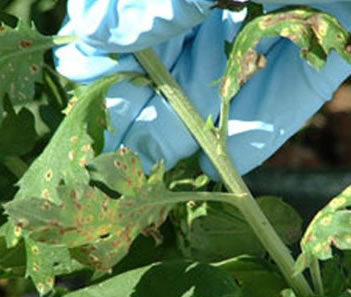
|
Rust is a serious disease especially in the early spring. The disease symptoms are
in the form of brown blister-like swellings, which appear on the undersides of leaves.
These burst open releasing masses of brown, powdery spores. Severely infected plants
become very weak and fail to bloom properly.
Control : Early removal of infected leaves/plants helps to prevent the further spread
of the disease. Spraying the plants with Karathane @0.025% or dusting with Wettable
Sulphur @0.2% is effective in controlling the disease.
|
Septoria Leaf Spot (Sepotria chrysanthemella):
|
Leaf spots occur during cool-wet periods of the rainy season. Since the pathogens
are spread through rain splashes the lowermost leaves get infected first. Serious
infection may result in premature withering of the leaves; the dead leaves hang
to the stem for some time. When flowering starts the infection occurs on flower
buds, which rot completely.
Control : This disease can be controlled by spraying carbendazim @0.05% six times
at 15 days intervals from the end of July or spraying Benomyl (0.1%) followed by
Captafol (0.2%) and Carbendazim (0.1%). Destruction of disease debris and avoiding
excessive irrigation is recommended.
|
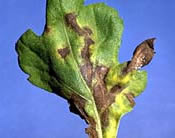
|
Stem Rot (Fusarium solani):
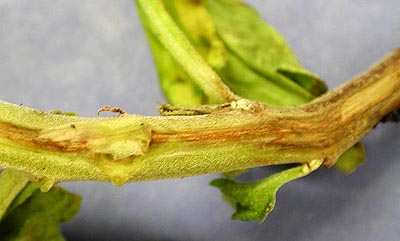
|
The disease is noticed in cuttings, stock plants and flowering plants. It is serious
during rainy weather. The affected plants show different symptoms such as leaf chlorosis,
necrosis, decay and discoloration of internal portion of the stem. When the flower
buds are about to open, small dark streaks are seen at the base of the stem. Root
decay is noticed only in advanced stages of infection. In many cases the infection
is devoid of any external symptoms and roots also look healthy. In some cases stem
and root rot are confined to one side of the stem, the other side remaining healthy.
Control : Cuttings should be taken from healthy plants. Following strict field sanitation,
rouging of infected plants and crop rotation helps to minimize the disease incidence.
Spraying with Carbendazim (0.1%) or Bordeaux mixture (1%) and avoiding excessive
moisture in beds help in checking the disease.
|
Powdery Mildew (Oidium chrysanthemi):
Infection is more severe in older plants under humid conditions. The growth of the
fungus on the leaves appears as powdery coating. Infected leaves turn yellow and
dry out. Infected plants remains stunted and fail to flower.
Control : Disease can be effectively controlled with Sulphur fungicides or Captan
(0.2%). Good ventilation and proper spacing for free circulation of air is recommended.
Source: http://www.ficciagroindia.com/production-guidelines/flowers/Chrysanthemum/diseases.htm
Top
Harvest
Spray mums are generally harvested at the two thirds to three-fourths open stage;
standard mums at the three-fourths to full open stage of development. Flowers to
be shipped long distances should be harvested when approximately one-half open.
Flowers must be harvested late in the afternoon or early morning.
Top
|